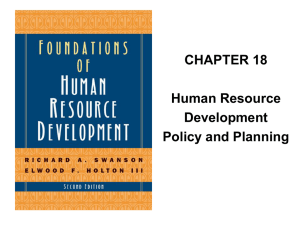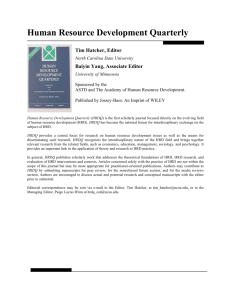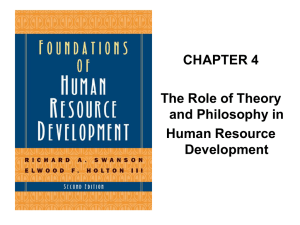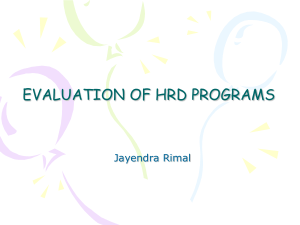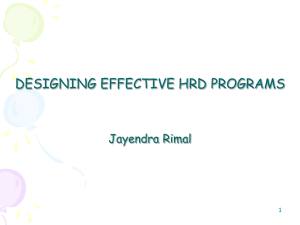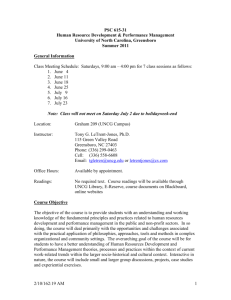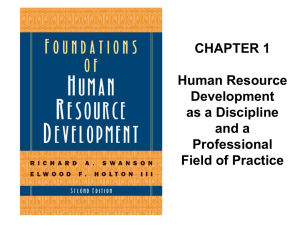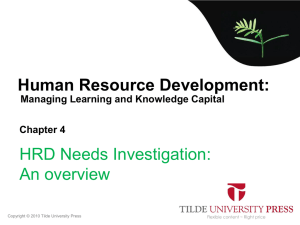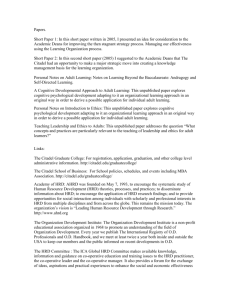UNIT-I Concept origin and needs of HRD HRD Matrix HRD matrix
advertisement
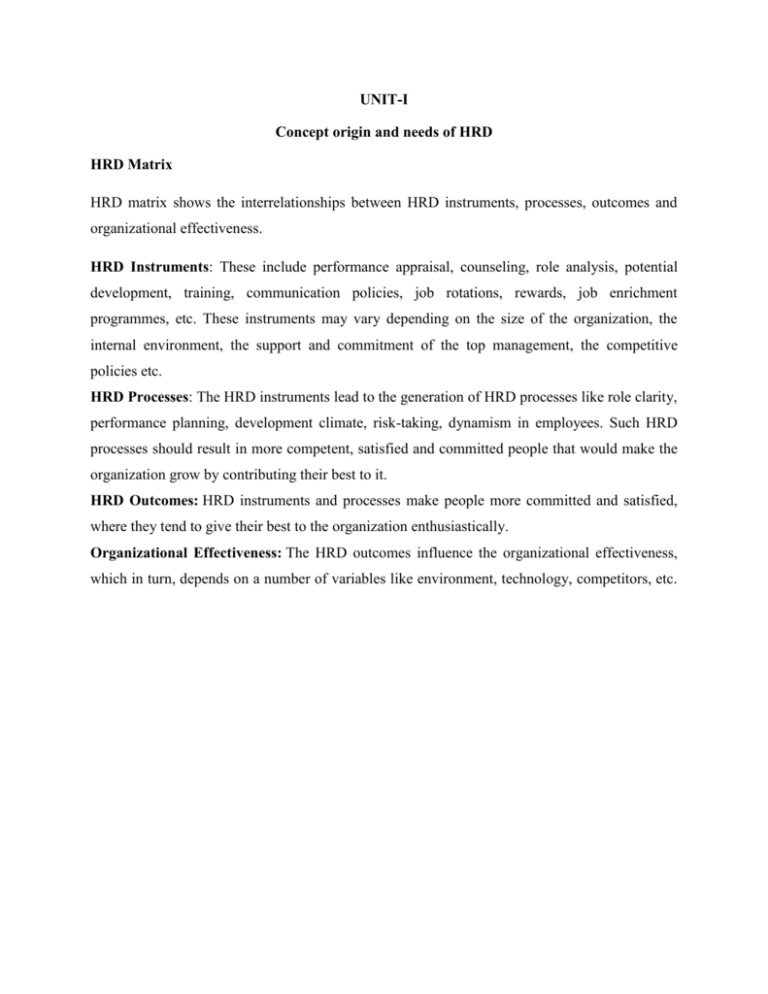
UNIT-I Concept origin and needs of HRD HRD Matrix HRD matrix shows the interrelationships between HRD instruments, processes, outcomes and organizational effectiveness. HRD Instruments: These include performance appraisal, counseling, role analysis, potential development, training, communication policies, job rotations, rewards, job enrichment programmes, etc. These instruments may vary depending on the size of the organization, the internal environment, the support and commitment of the top management, the competitive policies etc. HRD Processes: The HRD instruments lead to the generation of HRD processes like role clarity, performance planning, development climate, risk-taking, dynamism in employees. Such HRD processes should result in more competent, satisfied and committed people that would make the organization grow by contributing their best to it. HRD Outcomes: HRD instruments and processes make people more committed and satisfied, where they tend to give their best to the organization enthusiastically. Organizational Effectiveness: The HRD outcomes influence the organizational effectiveness, which in turn, depends on a number of variables like environment, technology, competitors, etc. UNIT-II HRD INTERVENTIONS A system has its own objectives, components or elements and a process. It has inputs an output and throughput. The objective if HRD system is to build a lasting culture so that employees learn and give of their best on a continuous basis. Culture can be divided in terms of values and norms The instruments available for an organization are put into subsystems and become HRO systems or subsystems. The following instruments available in the past, have been put into subsystems 1.induction training 2.Training 3.Performance planning 4.Performance analysis & review 5.performance counseling 6.Performance development 7.Performance appraisals 8.Rewards & recognition 9.Potential appraisal and development 10.carrier paths and other team based activities 11.communications 12.quality circles and other team based activities 13.Job rotation 14.Organisational diagnosis development 15.Team building, role clarity and other mechanisms These are most frequently used instruments that can be converted into instruments/subsystems, which are propagated to ensure maximum achievement of HRD goals. As we convert the instruments into systems/subsystems some of them get grouped either for administrative continence or to ensure synergy in terms of value.For example, induction training and training get grouped to form to form the training system. The training system attempts to ensure that instrument of training is used effectively, cost effectively , appropriately and not misused. It becomes a system by formulating its own objectives, elements, inputs, outputs and process. IT is the inputs and the output of the systems that link to the other subsystems The following subsystems have been extensively used in last 25 years of HRD in India HRD interventions/ HRD mechanisms/Methods The following subsystems have been used extensively used in the last 25 years of HRD in India Training Performance appraisal Potential appraisal Counseling Coaching Mentoring Career planning and development Organizational development 1.Training Training may be considered as a short educational process and process of learning sequence of programmed behavior. It is an application of knowledge. It gives people an awareness of some of the rules and procedures to guide their behaviors. It is the act of increasing the knowledge and skill of employee for a particular job. Thus, training bridges the difference between job requirements and employees’ present specifications. 2.Performance appraisal Performance appraisal is an evaluation of the performance of an employee against the job standards in terms of quantitative, qualitative and behavioural aspects at the workplace. A successful PA process involves explaining the job, communicating expectations, observing and documenting behaviour and providing frequent informal feedback. “It is the systematic evaluation of the individual with respect to his or her performance on the job and his or her potential for development” Objectives of performance appraisal To effect promotions based on competence and performance To assess the training and development needs of an employees To let employees know where they stand insofar as their performance is concerned To determine whether Hr programmers have been effective or not Main components of performance management system Identification of KRAs Setting of goals or objectives(under each KPA) every year for the next year Periodic review of performance Identification of behavioral dimensions that are critical for managerial effectiveness 3.Potential appraisal The potential appraisal refers to the appraisal i.e. identification of the hidden talents and skills of a person. The person might or might not be aware of them. Potential appraisal is a future – oriented appraisal whose main objective is to identify and evaluate the potential of the employees to assume higher positions and responsibilities in the organizational hierarchy. 4.Counseling 5.Coaching 6.Mentoring 7.Career planning and development Carrier planning is a process by which one selects carrier goals and path to this goals.The major focus of career planning is on assisting the employees achieve a better match between personal goals and opportunities that are realistically available in organization. Carrier planning is not an event or end im itself, but a continuous process of developing human resources for achieving optimum results. Carrier development consists of the personal actions one undertakes to achieve a carrier plan. Carrier development looks at long-term carrier effectiveness of employees. The actions for carrier development can be initiated by the individual himself or by the organization. 8.Organizational development Organizational development is a long-term approach to change that aims to move on entire organizations to higher level of functioning , while greatly improving employee performance and satisfaction. Although OD frequently includes structural changes, its primary focus is on changing people and the nature and quality of their working relationships According to Wendell French , “ OD refers to a long range effort to improve an organization’s problem-solving capabilities and ability to cope with changes in its external environment with the help of consultant or change agent Characteristics Focus on whole organization Problem-solving Group process Team building Experimental learning ORGANIZATIONAL DEVELOPMENT PROCESS The Organizational Development (OD) process is complicated and it takes long time to complete the process. It takes minimum of one year and sometimes continues indefinitely. There are different approaches to OD process but the typical process consists of seven steps, viz., initial diagnosis, data collection, data feedback and confrontation, action planning and problem solving, team building, inter group development and evaluation and follow-up. 1. Initial Diagnosis: If executives recognize that there are inadequacies within organization which can be corrected by OD activities, it is necessary to find out the professional and competent people within the organization to plan and execute OD activities. If competent people are not available within the organization the services activities are to be taken. The consultants adopt various methods including interviews, questionnaires, direct observation, analysis of documents and reports for diagnosing the problem. 2. Data Collection: Survey method is used to collect the data and information for determining organizational climate and identifying the behavioral problems. 3. Data Feedback and Confrontation: Data collected are analyzed and reviewed by various work groups formed from this purpose in order to mediate in the areas of disagreement or confrontation of ideas or opinions and to establish priorities. 4. Selection and Design of Interventions: The interventions are the planned activities that are introduced into the system to accomplish desired changes and improvements. At this stage the suitable interventions are to be selected and designed. 5. Implementation of Intervention: The selected intervention should be implemented. Intervention may take the form of workshops, feedback of data to the participants, group discussions, written exercises, on-the-job activities, redesign of control system etc. Interventions are to be implemented steadily as the process is not a “one-short, quick cure” for organizational malady. But it achieves real and lasting change in the attitudes and behavior of employees. 6. Action Planning and problem Solving: Groups prepare recommendations and specific action planning to solve the specific and identified problems by using data collected. 7. Team Building: The consultants encourage the employees throughout the process to form into groups and teams by explaining the advantages of the teams in the OD process, by arranging joint meetings with the managers, subordinates etc. 8. Inter group Development: The consultants encourage the inter group meetings, interaction etc., after the formation of groups/teams. 9.Evaluation and follow-up The organization finally has to evaluate the OD programs, find out their utility, and develop the programs further for correcting the deviations and/or improved results. The consultants help the organization in this respect. All the steps in the OD processes should be followed by the organization in order to derive full range of OD benefits Organization Development Interventions Organization Development (OD) interventions techniques are the methods created by OD professionals and others. Single organization or consultant cannot use all the interventions. They use these interventions depending upon the need or requirement. The most important interventions are, 1. Survey feedback 2. Process Consultation 3. sensitivity Training 4. The Managerial grid 5. Goal setting and Planning 6. Team Building and management by objectives 7. Job enrichment, changes in organizational structure and participative management and Quality circles, ISO, TQM Survey feedback: The intervention provides data and information to the managers. Information on Attitudes of employees about wage level, and structure, hours of work, working conditions and relations are collected and the results are supplied to the top executive teams. These teams analyze the data, find out the problem, evaluate the results and develop the means to correct the problems identified. The team are formed with the employees at all levels in the organization hierarchy i.e, from the rank and file to the top level. Process Consultation : under this method , the process consultant meets the members of the department and work teams observes their interaction, problem identification skills, solving procedures et. He feeds back the team with the information collected through observations, coaches and counsels individuals & groups in moulding their behavior. Goal setting and planning : Each division in an organization sets the goals or formulates the plans for profitability. These goals are sent to the top management which in turn sends them back to the divisions after modification . A set of organization goals thus emerge there after. Managerial grid: This identifies a range of management behavior based on the different ways that how production/service oriented and employee oriented states interact with each other. Managerial grid is also called as instrumental laboratory training as it is a structured version of laboratory training. It consists of individual and group exercises with a view to developing awareness of individual managerial style interpersonal competence and group effectiveness. Thus grid training is related to the leadership styles. The managerial grid focuses on the observations of behavior in exercises specifically related to work. Participants in this training are encouraged and helped to appraise their own managerial style. UNIT-III Training Training may be considered as a short educational process and process of learning sequence of programmed behavior. It is an application of knowledge. It gives people an awareness of some of the rules and procedures to guide their behaviors. It is the act of increasing the knowledge and skill of employee for a particular job. Thus, training bridges the difference between job requirements and employees’ present specifications. Dale S.Beach define the training as the organized procedure by which people learn knowledge and/or skills for a definite purpose” Need For Training Training is a planned programme designed to improve performance and bring about measurable changes in knowledge, skills, attitude and social behaviour of employees. Training is essential for job success. It can lead to higher production, fewer mistakes, greater job satisfaction and lower turnover. helps new recruits to perform assigned tasks effectively helps existing employees to prepare for higher level jobs enables existing employees to keep in touch with latest developments permits employees to cope with changes brought in by frequent makes employees more versatile, mobile, flexible and useful to the organisation transfers bridges the gap what the employee has and what the job demands allows an employee to gain acceptance from peer groups readily CONCEPT OF LEARNING Learning is defined as relatively permanent change in behaviors that occurs as a result of experience. Learning is a relatively permanent change process and always refers to some systematic change in behavioral disposition that occurs as a consequence of experience in some situation over a period of time. Learning principles Models of human learning are studied in order to find out the reasons for fast accurate learning. The principles of learning developed by Sikula are as follows: a)All humans can learn b)An individual must be motivated to learn c)Learn may acquire knowledge more rapidly with giidence. Feedback ensures improvement in speed and more accuracy of learning d)Learning is active but not passive e)Appropriate material should be provided f)Time must be provided to practice learning g)Learning methods should be varied. Variety of methods should be introduced to off-set fatigue and boredom h)The learner must secure satisfaction form learning. Education must fulfill human needs, desires and expectations I)Learners need reinforcement of correct behavior J)Standards of performance should be set for the learner K)different levels of learning exists l) learning is an adjustment on the part of an individual m) Individual differences play a large part in effectiveness of learning process n) Learning is cumulative process o) Ego involvement is wildly regarded as major factor in learning p) The rate of learning decreases when complex skills are involved q) Learning is closely related to attention and concentration r)Learning involves long-run retention and immediate acquisition of knowledge s) Accuracy deserves generally more emphasis than speed t) Learning should be relatively based u) Learning should be a goal-oriented Training process Training methods & evaluation of training - Ref in P.Subba rao T.B pg no 265-271 i.e attached below Techniques of Evaluation The various methods of training evaluation are: Observation Questionnaire Interview The opinion and judgments of trainers , supervisors and peers Asking all trainees to fill evaluation form Giving oral and written tests to trainees to ascertain how far they have learnt Comparing training performance on job before and after training Measuring levels of productivity, wastage costs absenteeism and employee turnover after training Self recording of specific incidents Meaning of executive development Executive development is also called as management development Executive development is systematic and continuous process of improving the performance and potential of managers. It is a educational process through which executives learn conceptual and theoretical knowledge and managerial skills in organized manner Executive development is any planned effort to improve current and future managerial performance. Characteristics of executive development It is planned & organised process of learning. It is an ongoing or never-ending process. It is a long term process as managerial skills cannot be developed overnight. It aims at preparing executives for better performance and helping them to realise their full potential OBJECTIVES To improve the performance of managers at all levels in their present jobs To prepare managers for higher jobs in future To ensure availability of required number of managers with the needed skills To ensure that the managerial resources of the organization are utilized optimally To understand problems of HR and improve human relations skills . To stimulate creative thinking. METHODS OF EXECUTIVE DEVELOPMENT 1). On-the-job Techniques• Coaching-The superior guides and instructs the trainee as a coach. • Under Study- is a person who is training to assume at future time, the full responsibility of the position currently held by his superior. • Position Rotation-Involves movement of transfer of executives from one position or job to another on some planned basis. • Project Assignment-A number of trainee executives are put together to work on project directly related to their functional area. • Multiple Management –Under this system a junior board of young executives is constructed. Major problems are analysed in junior-board which makes recommendations to the board of directors. • Selective readings-By reading selected professional books and journals, managers can keep in touch with the latest findings, theories and techniques in management. 2). Off-the-job Techniques• Lectures –It is a simple way of imparting knowledge to a large number of persons within a short time. • Case Studies – A real business problem or situation is demanding solution is presented in writing to the trainees. • Group Discussions – This is followed by critical discussion. • Conferences - It is a formal meeting conducted in accordance with an organized plans. • Role Playing – In this method, the trainees act out a given role as they would in a stage play. • In Basket Exercise –Each trainee is provided with a basket or tray of papers and files related to his functional area. He is expected to carefully study these and make his own recommendations on the problem situation. Process of executive development Organizational environment-- Organizational strategy/objectives Identifying competency gaps>Training needs assessment--> Training plan--> Conduct of the training program
